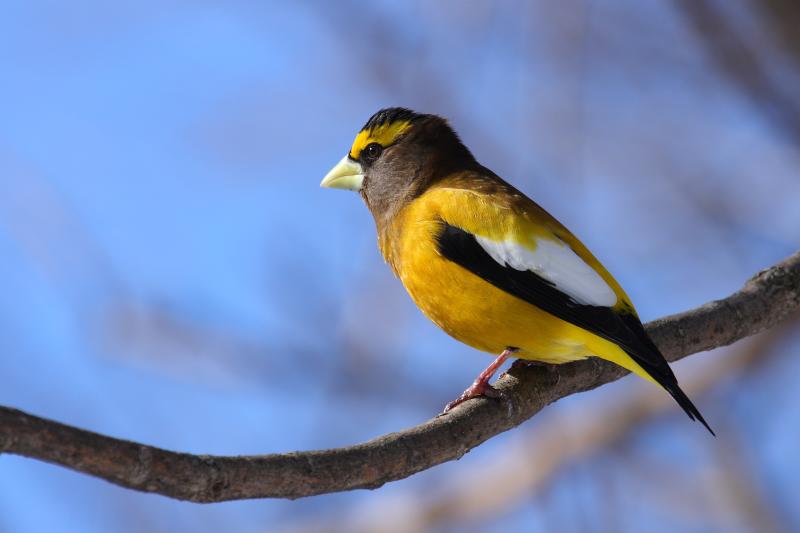The Grosbeaks are Coming

Are there any of you out there that remember the days when people would complain about how evening grosbeaks were eating them out of house and home? Back in the 1970s, we remember bird lovers everywhere talking about buying a hundred pounds of sunflower seed every two weeks (sometimes more) to feed the flocks of literally fifty or hundred, or more, evening grosbeaks coming daily to their backyard feeders in the winter.
And then they were gone…
Since that time most birders count themselves lucky to have seen a couple of them at a feeder or hear some flying overhead once or twice a season. Sure, there are some places up north where people have small flocks in the winter, and they do breed in some places up in northern Maine as well. But still, their populations have been only a small reflection of what it once was during those pre-1980s winters.
That’s why we have been excited to see that this year there has already been a southward irruptive movement of evening grosbeaks documented across much of the U.S. Through eBird, we see that birders as far south as the Outer Banks of North Carolina, Virginia, Kentucky, southern Illinois, and southern Missouri have documented evening grosbeaks in October and these first days of November. Evening grosbeaks have been found already at birding mecca—Cape May, New Jersey—and around Washington, D.C., in the last few weeks.
Here in Maine, there have been many reports of evening grosbeaks. Some at feeders where eager and lucky birder have had the chance to photograph them. Some have been flying high overhead, faintly heard as they passed south. We’ve heard a couple flying over high above in the last week in the neighborhood while walking the dog, but we are still hoping one or more may stop off where we can see them, too!
It’s always hard to say with irruptive finches like evening grosbeaks whether there will be an initial early season movement across the area that dribbles down to a very few that stay longer or for the winter. Sometimes irruptive finches just burst through early but then are not seen again (or there are only a few at certain lucky feeders).
We have been enjoying watching house finches, a few purple finches, and an occasional dark-eyed junco feeding on the seeds of a towering white ash tree on our neighbor’s property. We keep hoping that this natural food source that seems to be so attractive to these birds might attract some hungry evening grosbeaks as well. Something that we have found very curious is that several other white ash trees in our neighborhood are also heavily laden with seeds like this tree that has been so popular with the birds. But we never see any birds feeding in these other trees. Do some trees of the same species produce more tasty or nutritious seeds? Or maybe our timing is just off and the birds are indulging during times when we’re not watching. It remains a mystery to us.
We hope some of you may have the good fortune to have some big-billed, yellow-and-white evening grosbeaks stop by your backyards. Keep your eyes open for these special birds!
Jeffrey V. Wells, Ph.D., is a Fellow of the Cornell Lab of Ornithology and Vice President of Boreal Conservation for National Audubon. Dr. Wells is one of the nation's leading bird experts and conservation biologists and author of the “Birder’s Conservation Handbook.” His grandfather, the late John Chase, was a columnist for the Boothbay Register for many years. Allison Childs Wells, formerly of the Cornell Lab of Ornithology, is a senior director at the Natural Resources Council of Maine, a nonprofit membership organization working statewide to protect the nature of Maine. Both are widely published natural history writers and are the authors of the popular books, “Maine’s Favorite Birds” (Tilbury House) and “Birds of Aruba, Bonaire, and Curaçao: A Site and Field Guide,” (Cornell University Press).




























